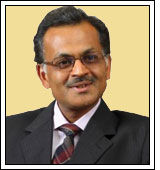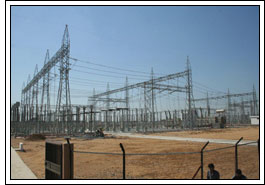 — Hemant Kanoria,
Chairman, DPSC Ltd
DPSC Ltd
— Hemant Kanoria,
Chairman, DPSC Ltd
DPSC Ltd (formerly Dishergarh Power Supply Company) is
amongst the oldest utility in India, Part of the public sector Andrew
Yule Group, DPSCL operated in eastern India. In 2009, DPSC was
bought by private sector investors.
Hemant Kanoria, in this
exclusive interaction with Electrical Monitor, gives a roadmap on
how DPSC in the new ownership plans to evolve as an integrated
power utility in the generation and distribution sector. An interview
by
Venugopal Pillai.
Take us through the new ownership structure of DPSC after
Orbis Power Venture took over controlling stake.
DPSC was on sale by Andrew Yule back in 2009. SREI in
consortium with India Power Corporation Ltd (IPCL) emerged
as the highest bidder for a majority stake in DPSC. At present,
IPCL holds 93 per cent stake in DPSC. IPCL, in turn, is held by
renowned Venture Capital Funds like Infrastructure Project
Development Fund and financial institutions like SREI
Infrastructure that hold 9 per cent in IPCL.
Tell us how you plan to change the perception of DPSC from a
traditional public sector power distribution utility to a more
holistic private electricity service provider.
Following its acquisition in 2010, DPSC has ever since been on
a growth trajectory implementing modern and efficient ways of
operation. Some of the highlighting points are:
Smart Grid metering: The company has initiated Smart Grid
development process since last year. In our distribution
license area, we have successfully implemented Automated
Meter Reading (AMR) that generates consumer meter reading
reports and bills, real time with negligible variance in data. This
has resulted in savings towards lead time for meter reading
and bill generation and also increased the operational
efficiency by increasing the accuracy of data. Pursuant to the
success of this implementation, we are progressing forward to
ensure real time data management and availability at the
receiving feeders that will enable T&D loss management,
further adding to its operational efficiency.
Low T&D: DPSC, through its efficient power distribution, has
maintained one of the lowest T&D loss figure across India.
Through our better control systems and regular quality checks
we ensure minimum loss. Also, by an extensive augmentation
of our existing systems by building new infrastructure, we have
been able to keep a consistent check on energy losses through
our networks.
Integration Process: In the near future, we would undertake
an integration process by the amalgamation of IPCL and DPSC.
We believe that this synergistic integration shall result in
consolidation of our power businesses into one and we shall
emerge as a bigger player in the sector with operations in
power generation and distribution. The amalgamation would enable us to have a large asset base, access to better financial
resources and will enable us to manage our business more
efficiently by effectively pooling the technical, distribution and
marketing skills of each other, resulting in an optimal
utilization of resources.
What is the status of DPSC’s proposed 540-mw Raghunathpur
coal-fired power plant in West Bengal? When do you expect full
commercial operations?
At Raghunathpur, we are setting up a 2x270 (540-mw) thermal
power plant with an investment of around Rs.3,084 crore. The
project has received water allocation for the first phase and
other necessary project consents and approvals are also
underway. Land acquisition for the project is also on track with
significant areas already acquired. However, given the state of
the market at present, we are moving forward with care.
What are your eventual plans for the existing 12-mw
Dishergarh power plant?
The existing Dishergarh power plant has been completely
overhauled through a renovation and modernization exercise.
The new plant is undergoing testing and would be
commissioned soon. This 12-mw power plant provides system
stability to the DPSC grid by acting as a reserve supply source.
 Do you feel that the ongoing controversy regarding coal blocks
will affect thermal power capacity addition in the near future?
Do you feel that the ongoing controversy regarding coal blocks
will affect thermal power capacity addition in the near future?
The last few years have seen significant generation capacity
addition being done. However, a lot of these projects are facing
adverse issues today due to concerns related to fuel
availability. The ongoing controversy related to coal blocks is
just one of the many issues related to fuel availability in India.
This includes fuel linkages, fuel transportation, quality, prices,
etc, for both coal and gas. We believe a fresh look needs to be
taken on the entire primary energy supply issue rather than
dealing with symptomatic concerns only when crisis erupts.
We perceive that the government’s effort in privatizing of
power distribution circles has met with mixed success. What is
your view?
While policy level views have been announced on the possibility
of private participation in the distribution sector, either
through distribution franchisees or public-private
partnerships, yet this has only seen some cases being
implemented. A complete overhaul of the dynamics of
distribution needs to be effected for the sector to be selfsustaining
and viable.
Does DPSC plan to bid for circles outside its command area that
might come up for privatization?
DPSC Ltd is focused on the development of its distribution
business. This includes its licensed area as well as any other
opportunities in the distribution space that are available, which
utilize DPSC’s core capabilities of providing electricity services
to its consumers in the most efficient manner. Any case of
privatization would of course be viewed with this lens and any
investment decisions of such nature would be seen on a caseto-
case basis.
 In a general sense, much of India’s power sector ambitions
rest on private sector participation – in all areas of generation,
transmission and distribution. What challenges do you foresee
and how can the government play better its role as facilitator?
In a general sense, much of India’s power sector ambitions
rest on private sector participation – in all areas of generation,
transmission and distribution. What challenges do you foresee
and how can the government play better its role as facilitator?
The power sector’s importance towards the growth of the
economy at large cannot be overemphasized. Despite that, it
has been facing acute constraints in its development. Some of
the bottlenecks that we can perceive, in no particular order,
are as follows:
Fuel availability: Coal and gas supply constraints have
impacted operational power projects across the country and
have created huge obstacles for projects that are under
implementation.
Financial health of state power utilities: Huge accumulated
losses and a continued resistance to increase tariffs, has
created a situation where power at very low prices are
available in the power markets and yet load shedding continues
in several parts of the country.
Private participation in distribution and open access: Power
distribution in India needs infusion of private sector funds and
efficiencies to draw it out of a downward spiral of technical and
commercial losses, deteriorating network infrastructure and
consequent financial ill-health. In addition to this, Open Access
needs to be provided in both letter and spirit to users and
suppliers across the country so as to instill competitive
efficiencies in the sector.
The most important step is to revive the financial health of the sector. This can be done only if power distribution sector
becomes more efficient. The participation of private sector is
extremely important as both private investments and
efficiencies are critical in overhauling the fundamentals of the
sector. In addition to that, support by electricity regulatory
commissions in ensuring that the sector remains financially
viable through appropriate tariff adjustments is vitally
important as well.
In its new avatar as a private sector power utility, please
summarize your growth plans for DPSC for the coming 3-5
years.
The Group plans an investment of Rs.25,000 crore for a
generation capacity of 4,300 mw over the next five years. A
450-mw thermal coal plant in Haldia will be commissioned by
2014 and a 540-mw plant in Raghunathpur would be pursued as
per plans. The company has executed MoUs with state
governments for setting up generation plants of 1,320 mw in
Bihar, 1,320 mw in Gujarat and 660 mw in Madhya Pradesh. The
company is achieving statutory approvals for the same and land
identification is in process.
To strengthen its distribution network, the company plans to
set up 400kV and 220kV substations within the licensed area to
provide required connectivity with the national and state grid. It
also plans to strengthen the distribution network by augmenting
its lines and enhancing its network to provide better services to
its consumers. In this segment, the new investment will be
around Rs.1,450 crore in the next few years capable to cater to
an increasing load growth in the license area.
In addition to this, we would also be participating in other
opportunities in the distribution space including distribution
franchisees or privatization bids on a case-to-case basis.